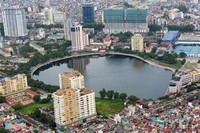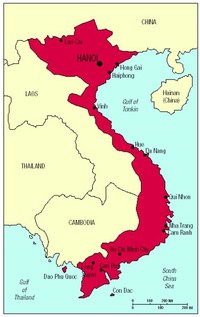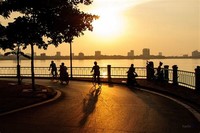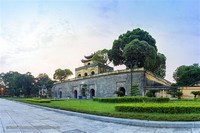Facts about Hanoi

Hanoi (Vietnamese: Hа N?i, Hбn T?: ??), estimated population 3,145,300 (2005), is the capital of Vietnam.

When the First Indochina War ended in 1954, Hanoi had an area of about 130 square kilometers.

Hanoi became the capital of Vietnam when North and South Vietnam were reunited on July 2, 1976.

Most of the current residents of Hanoi are from different provinces all over the country; the proportion of families who have lived there for more than three generations is small.

The Union Express (tаu Th?ng Nh?t) leaves from Hanoi Station (formerly Hang Co station), to Ho Chi Minh City, with stops at cities and provinces along the line.

Hanoi is located at 21°2' North, 105°51' East, 1760 km (1094 mi) north of Ho Chi Minh City (formerly Saigon).

Trains also depart Hanoi frequently for Hai Phong and other northern cities.

Along with its economic growth, Hanoi's appearance has also changed significantly, especially in recent years.

In 2003, Hanoi had 2,000 businesses engaged in foreign trade, having established ties with 161 countries and territories.

Hanoi is served by Noi Bai International Airport, located in the Soc Son District, approximately 40 km (25 miles) north of Hanoi.

Hanoi is also home to a number of museums, including the Vietnamese National History Museum, the National Museum of Ethnology, the National Museum of Fine Arts and the Revolution Museum.

The Old Quarter, near Hoan Kiem lake, has the original street layout and architecture of old Hanoi.

Hanoi experiences the typical climate of northern Vietnam, where summers are hot and humid, and winters are relatively cool and dry.

Hanoi is located on the right bank of the Red River, 1760 km (1094 mi) north of Ho Chi Minh City (formerly Saigon) at 21°2' North, 105°51' East.

In 2004, a massive part of the 900-year-old citadel was discovered in central Hanoi, near the site of Ba Dinh square.

West Lake (H? Tвy), the largest lake in Hanoi, is a popular recreational site, and there are many temples in the area.

Hanoi was occupied by the French in 1873 and colonized by them ten years later.

The spectacular Ban Gioc Waterfall, 272 km north of Hanoi, is a popular destination for tourists.

During the Vietnam War, Hanoi's transportation facilities were disrupted by the bombing of bridges and railways, which were, however, promptly repaired.

Agriculture, previously a pillar of Hanoi's economy, has been reformed through the introduction of new high-yield plant varieties and livestock, and the application of modern farming techniques.

Hanoi served as the capital of successive dynasties from the eleventh century to the eighteenth century.

Hanoi has had many names throughout history, all of them of Sino-Vietnamese origin.

A Chinese immigrant town first appeared within Hanoi in the fifteenth century.

The majority of universities in Hanoi are public, although in recent years a few private universities have started operation.

The area around modern Hanoi has been inhabited since at least 3000 B.C.E.

The considerate and genteel nature of Hanoians is occasionally referred to in idioms and literature.

Hanoi hosts more cultural sites than any city in Vietnam, including over six hundred pagodas and temples.

The population of Hanoi is about 3,145,300 (2005), with an overall population density of 3,495 people per square kilometer.

Hanoi's population is constantly growing, a reflection of the fact that the city is both a major metropolitan area of northern Vietnam, and also the country's political center.

Following the end of the war, Hanoi became the capital of Vietnam when North and South Vietnam were reunited on July 2, 1976.

The governor general of French Indochina was established in Hanoi after 1887, and it again became a center of political importance.

After the communists took control of Hanoi in 1954, with support from Soviet Union, some new universities were built, among them, Hanoi University of Technology, which is still the largest technical university in Vietnam.

Hanoi was called Ke Cho (place of the markets) because it had so many markets.

Hanoi has the highest Human Development Index among the cities in Vietnam.


